‘Cattle drivers, marauders, terrorists and hooligans’
Published in Features, Issue 4 (July/August 2020), Volume 28The agrarian movement of 1920.
BY TERRY DUNNE
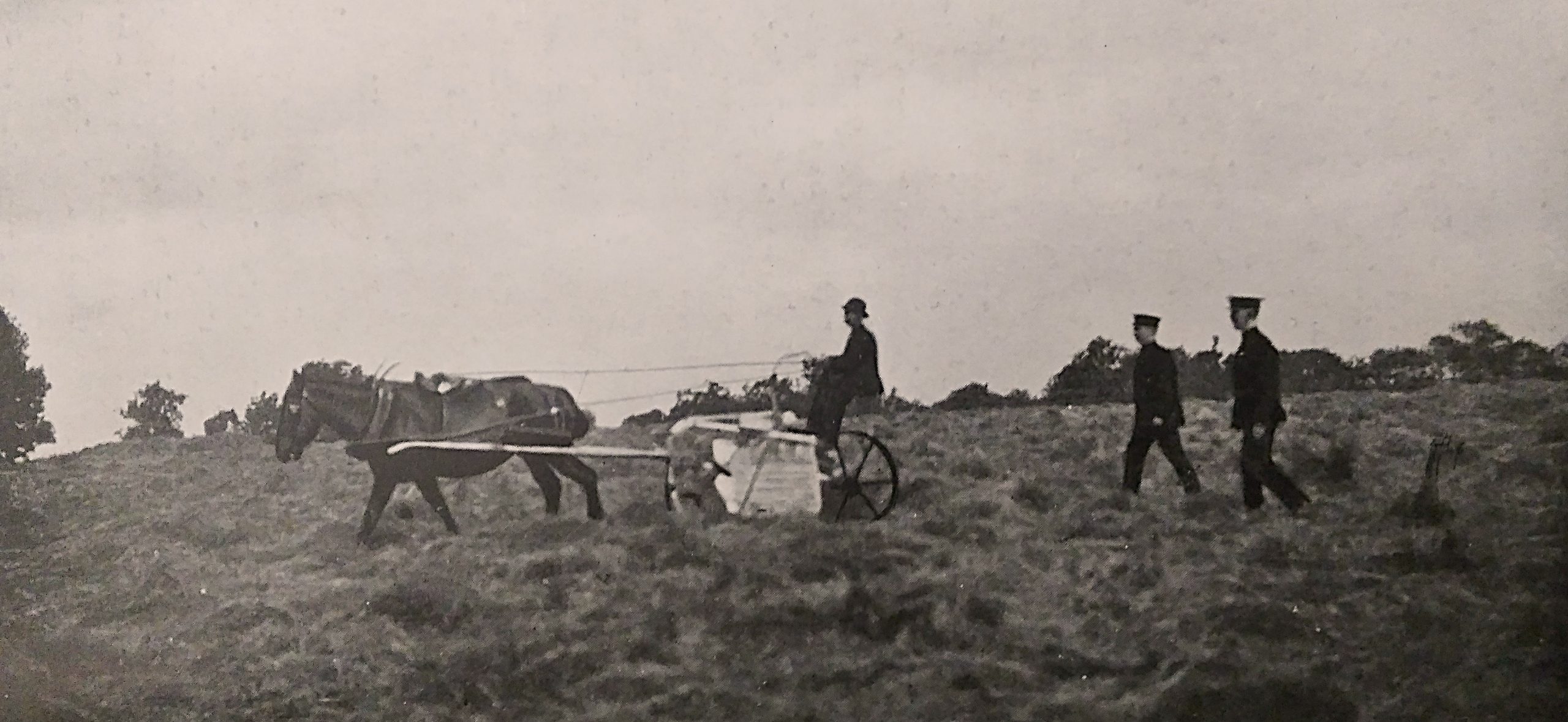
Above: Guarding the hay harvest—RIC men in Meath, 1908. (NLI)
An t-Óglách, the IRA newsletter, starkly pronounced on 1 May 1920: ‘The Irish Republican Army has found it necessary to take drastic steps for the enforcement of law and order’, and went on to specify the problem of ‘land-greed’ in Kerry. In Watchword of Labour, the newspaper of the Irish Transport and General Workers’ Union (ITGWU), on the same date was a letter arguing that ‘there are large tracts of land in the hands of a few, so that if a fair divide of the land was made there would be plenty to secure a decent living for all rural workers’. The contrast illustrates the complex relationship between the separatist and agrarian struggles, a relationship that grew more complex as much of the focus of agrarian conflict shifted from the terms under which farmers held their land to issues over the distribution of farmland.
In the revolutionary years there were three phases of land conflict: in the early months of 1918; in the spring and early summer of 1920; and in 1922–3. Additionally, all through the 1917–23 period there were mobilisations of agricultural wage workers, usually centred on wages and employment conditions. Agrarian social conflict was regionally distinct—in the East the focus was on wages, in the West on land. This reflects a pattern of economic development where labour-intensive forms of agricultural production, such as tillage and dairying, were clustered in Leinster and east Munster. Consequently, these regions had a greater concentration of agricultural wage labourers. The West, on the other hand, had a proportionally larger small-farmer element to its population.
In 1920 the constabulary recorded more so-called agrarian outrages than for any year since 1882. At the time much previous experience suggested that republicans would embrace this renewed spirit of revolt. Sinn Féin and the Volunteers led the 1918 movement whereas in 1920 republican leaderships, both nationally and locally, sought to constrain agrarianism. Doubtless there was local dissent from this line—and a considerable amount of autonomous action. It is worth stressing that there was no great argument against land reform per se—even the British government was already engaged in a degree of redistribution; rather it was the timing, the means and the extent of land reform that were the issues.
The land for the people?
Some advocates of an Irish-Ireland saw farmland redistribution as an inherent and central part of the process of decolonisation. Sinn Féin journalist William Bulfin wrote of his ‘yearning, hungry hope’ for the ‘day that will see English rule swept out of the island’ and the ‘grassy desert’, the ‘grazier-made wilderness’ be ‘divided up’ and ‘dotted once more with peaceful, happy, God-fearing, God-serving, patriotic Irish homes’. The Marxist James Connolly dissented from this smallholder ideal, arguing that ‘every fresh application of science to agriculture, every cheapening of transit brought about by the development of transatlantic commerce, everything in short which increases the facilities of trade, tends to cheapen the price of agricultural produce and leaves an ever-decreasing margin of profit for the cultivator’. The end result would be a ‘hopeless struggle for subsistence’ and ‘the doom of the petty farmers of Ireland under the capitalist system’. In the short term, albeit a long short term, Connolly was wrong. He underestimated the capacities of State intervention in the form of doles, subsidies and tariffs. By the second half of the twentieth century, though, the tendency of centralisation through competition that Connolly had written about was slowly asserting itself. Ostensibly the mainstream separatist view was for breaking up the ranches, for a paradise of small property-owners (though both Sinn Féin and the ITGWU did experiment with co-operative farms). A Sinn Féin pamphlet published in late 1917—written by long-time agrarian radical Laurence Ginnell—asked ‘why have not the ranches, which are all evicted lands, been distributed among evicted tenants, holders of uneconomic farms, labourers, farmers’ sons and other landless people …’ and admonished ‘young landless people’ to ‘clear cattle off every ranch, and keep them cleared until distributed’.
Congests and ranchers: the social structure of Connacht
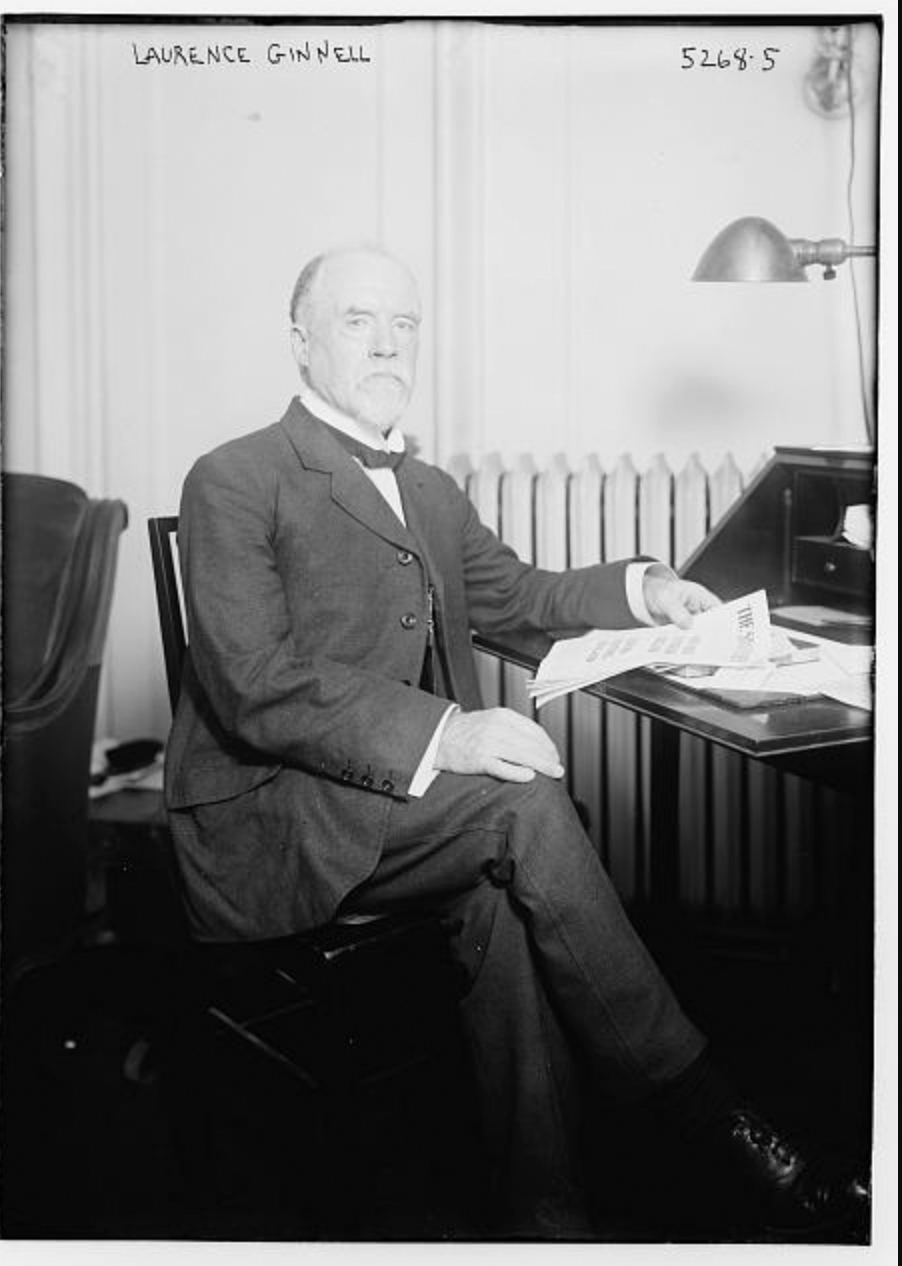
Above: Long-time agrarian radical Laurence Ginnell—a Sinn Féin pamphlet that he authored in late 1917 admonished ‘young landless people’ to ‘clear cattle off every ranch, and keep them cleared until distributed’. (Library of Congress)
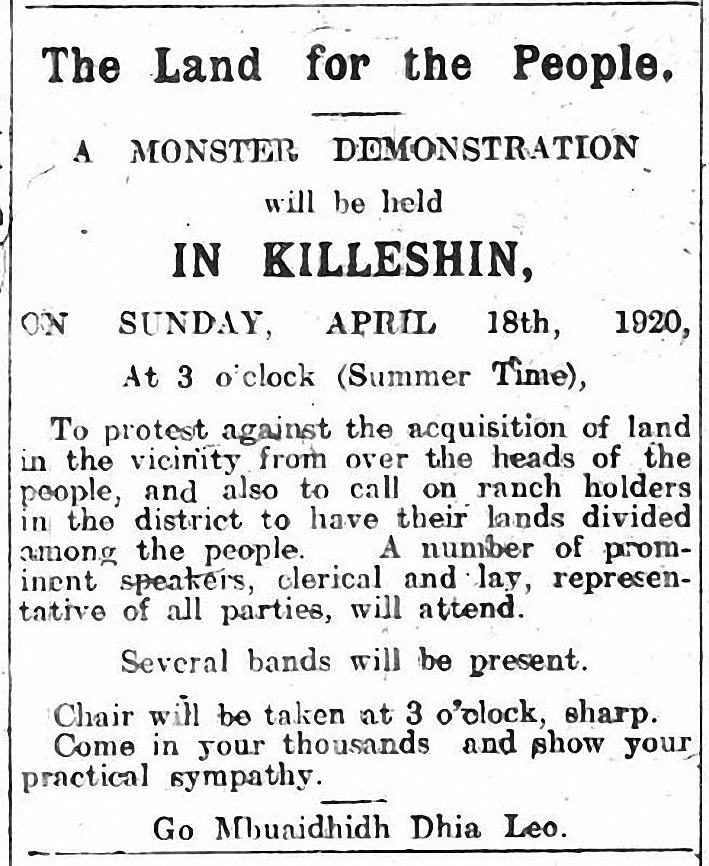
Above: Not just the West—mobilisation at Killeshin, on the borders of Laois and Carlow.
The core area of the 1920 movement was the East Connacht plain—the eastern half of Galway, Roscommon and adjacent parts of Mayo. In terms of social structure, the most apparent factor was a profound inequality in the distribution of farmland. Famine-era clearances had widened the land market, and so-called untenanted land—land let out for eleven months’ grazing—was monopolised by a wealthy set of ranchers or graziers. According to Kevin O’Sheil, a Dáil administration apparatchik sent to put a halter on the movement, these ‘astonishingly large areas of untenanted land’ consisted of the ‘primest and best fattening land’ as well as rough grazing that had formerly been in communal use. Meanwhile, most of the population was found on some of ‘the poorest and least productive land’ on holdings ‘wholly inadequate from any economic criterion’. These were what Ginnell called ‘the remnant of fugitives’ from ‘bullock-pastures’, ‘who live within sight of them on bogs, swamps and gravelly hills’. In addition, there was the continued presence of unpurchased tenants—i.e. tenants who still had a landlord—who had not purchased their holdings under the land acts. The smallholders were known as ‘congests’, from the official designation of ‘congested district’, and were in many cases semi-proletarianised, supplying seasonal labour to the farms of the Scottish Lowlands or a more permanent workforce for the United States.
More immediate factors behind the 1917–23 land claims included the curtailment of migration owing to wartime conditions; envy at the boom in cattle prices enjoyed by graziers; and the pausing of redistribution by the Congested Districts Board owing to budgetary constraints (this being a British government body set up to address the problems of the West). There were also considerable subsistence fears, leading to government controls of food prices and measures for compulsory tillage, as well as direct actions over exports and prices by the republican and labour movements. The issue of food supply made agrarian issues to some extent an urban as well as a rural concern—hence popular pressure for the provision of vegetable allotments and cow plots for townspeople.
Characteristics of social structure which are often seen as ‘natural’ are also worth bearing in mind. Firstly, the particular form of modernity experienced in most of Ireland in the nineteenth century was a colonial modernity, one that made most of Ireland more rural and more agrarian. Low labour demand, particularly pronounced in beef-raising areas as opposed to the dairy or tillage areas, left few livelihood prospects other than bovines or Boston. This, rather than some bucolic attachment to land, goes a long way towards accounting for the countryman’s bellicosity on the issue. Secondly, there was a profound inequality within farming families along lines of gender and age. Full masculine status came with landholding. Cognisance of all this helps make explicable land conflicts within kin groups, e.g. between nephews and their uncle, a widow and her in-laws, and even between brothers.
The Connacht cattle drives
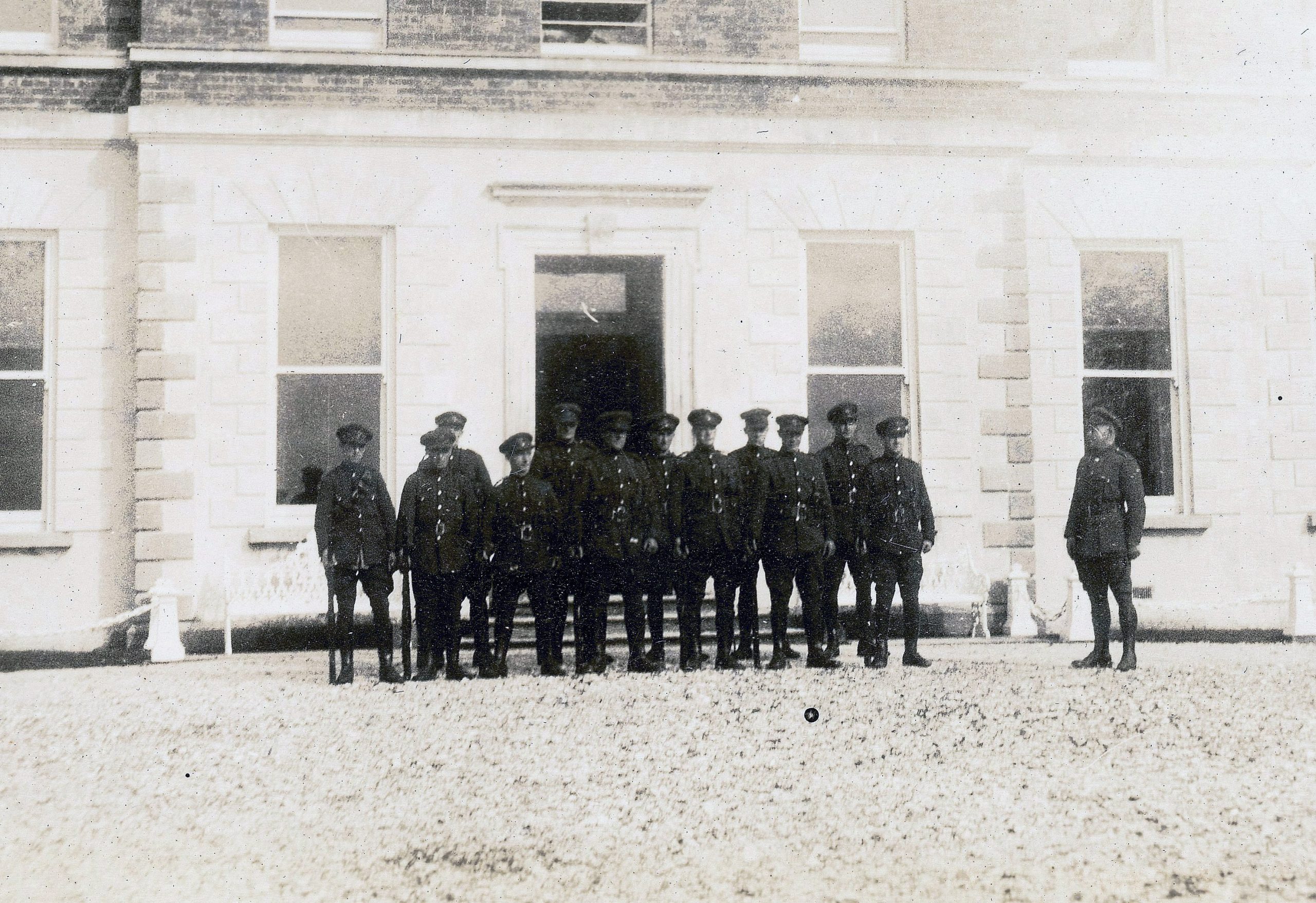
Above: Guarding the ‘big house’—Free State soldiers in Clare during a land dispute in 1923. (Clare County Library).
The most popular tactic of the agrarian movement was the cattle drive, which was simply an assembly of stick-wielding people herding cattle, sending them out onto the roadside, to nearby hills or even to the front lawn of their owner. This tactic had been popularised during the Ranch War of 1906–10. It was eminently practical because it denied opponents use of the disputed land. Before this there were deputations to visit landowners, to exhort them to sell up or to let out their land in smallholdings. Much of the older repertoire of agrarian insurgency was still present—threatening letters, the levelling of walls and gates, even assassination. Another means of intimidation was the digging of mock graves, complete with accompanying crosses.
Ground zero in 1920 was east Galway; the RIC report on conditions there in March reads:
‘A widespread agrarian agitation accompanied by murder, firing at the person, destruction of property and threatening letters, notices, etc., swept over it. The movement is fostered by Sinn Féin to popularise that party in the Riding but its strength is due to the land hunger always so prevalent in County Galway. A state of terror prevailed. Herds, farm and indoor servants in many cases have left their employers and the police could do little under the circumstances existing.’
The month had opened with the shooting dead of Frank Shawe-Taylor of Moorpark, Athenry. Shawe-Taylor was an extensive grazier. Subsequently his fate was used to emphasise the point in innumerable threatening letters.
In early April an especially ambitious cattle drive took place in south Roscommon; the cattle were to be driven to the square in Athlone to be exhibited as a deterrent. The drivers were dispersed by a charge of police armed with batons and soldiers armed with bayonets, while a Lewis machine-gun was mounted on the castle walls. By the second half of April the road between Strokestown and Roscommon was blocked with free-roaming cattle and sheep. In Mayo it was particularly the southern districts adjoining Galway and Roscommon that were affected, and notably in that area there were cattle drives consisting of women and children.
Clare, Kerry and Leinster
Social structure in these regions was more varied and complex than the starkness of east Connacht. The Bureau of Military History witness statements from the West and Mid-Clare brigades reveal a republican propensity for direct action against agrarian mobilisation. One speaks of the situation in Quilty, Co. Clare:
‘In those days it was a thickly populated district mainly comprised of small farmers and landless men such as fishermen and those of the labouring class who depended mainly on kelp burning for a livelihood. Situated in the locality, however, was a good sized non-resident grazing farm.’
A Volunteer company and priest were brought out in defence of the farm and were held back by stone-throwing locals. Cattle-driving, however, had been a seminal part of the infancy of republican insurgency in Clare.
In Ballyheigue, north Kerry, in late April 1920 a strong force of Sinn Féiners marched forth and—this being a Sunday morning before Mass—posted up placards ordering parishioners to desist from any land claims. A particular north Kerry innovation was the demand by farm workers for an extra acre of land. The background to this was the provision, under reforming legislation from London, of council houses and adjacent plots of an acre for the notoriously poorly housed Irish farm labourers. As in Clare, only a few years previously Sinn Féin and the IRA had been leading the demand for demesne lands to be given to the people of Listowel.
While all this is generally seen as a western matter, in fact the Ranch War (1906–10), which in many ways prefigured the 1920 movement, saw almost as much mobilisation in Meath as in any western county. In the revolutionary period the demand for land was much more a western phenomenon. Nonetheless there were exceptions, such as the Back to the Land movement, which had a stronghold in Meath.
Counter-revolution
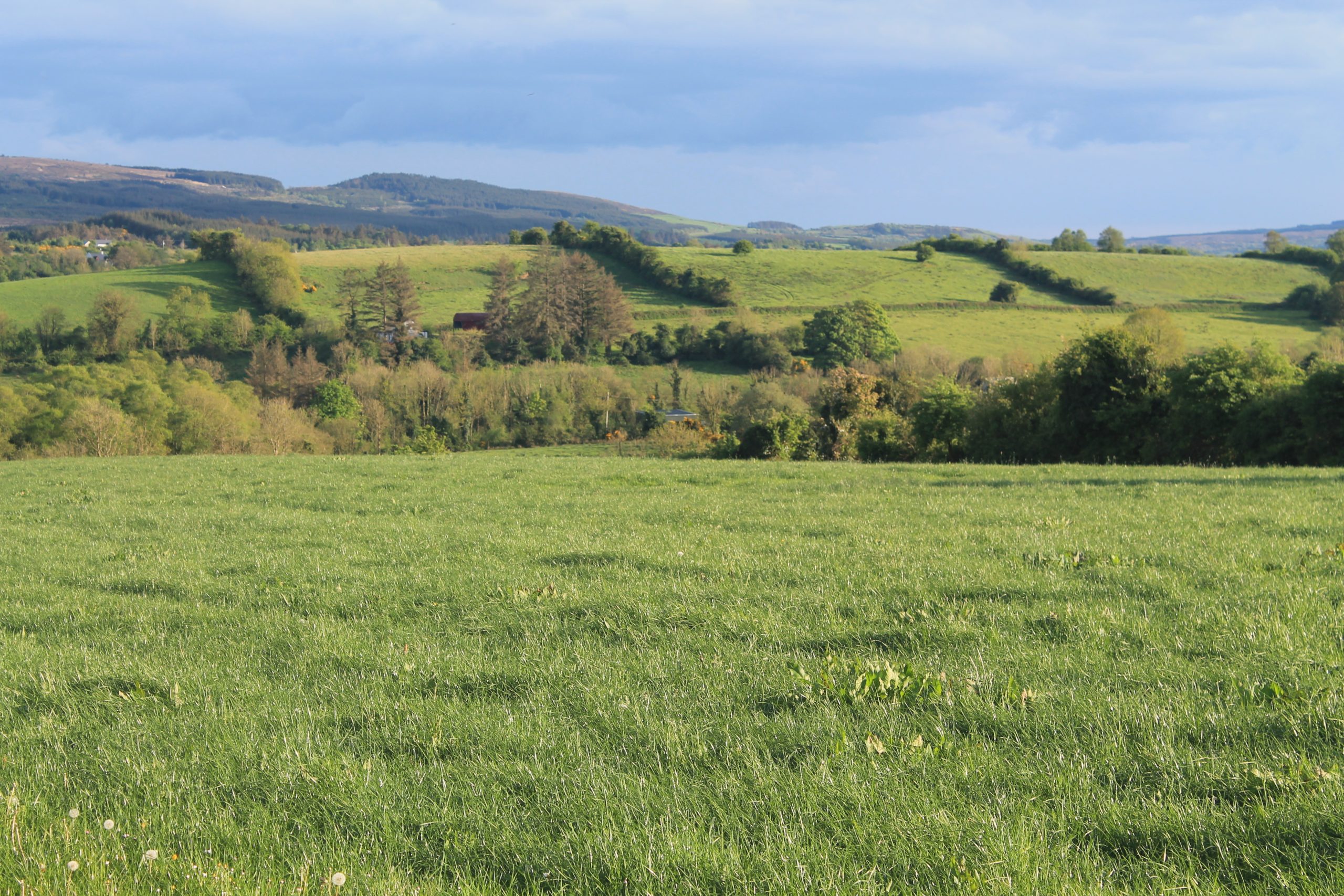
Above: Rectangular field pattern laid down in land reform under the Congested Districts Board in Knocklaur, east Clare.
‘The Free State was in existence long before the name was adopted’ was the acerbic comment of republican socialist Peadar O’Donnell. The counter-revolution began in late April and early May 1920. Clearly the potential for violent chaos existed within the cattle drives, as attested by intra-republican violence in Carrigaholt, Co. Clare, and Menlo, Co. Galway; mutual hostilities among smallholders; the division of extended families into rival factions; and the assassination of comparatively low-status victims such as herdsmen—none of which was anything particularly new to the annals of Irish agrarian insurgency. Undoubtedly, there was a need to create an organisational framework to deal with land issues. The point is that the one crafted by Sinn Féin favoured the landed over the land-hungry. Building on localised arbitration courts, Sinn Féin rolled out a more ambitious programme of Dáil land courts. The report penned by Roscommon Sinn Féiner Graham Sennett, revealingly entitled ‘Regarding Cattle Drivers, Marauders, Terrorists and Hooligans’, made plain the agenda of enticing ‘every rich man and every landed man, and every employer, and all the class of the men that read the Irish Times into the ranks’ of the republican movement. Tyrone republican Kevin O’Shiel was appointed as a special judicial commissioner for these courts. He himself admitted that in ‘the vast majority’ of the cases where he ruled in favour of congests and for the division and sale of lands this was ‘abortive’, as claimants could not meet the prices set by the court valuers.
In 1922–3 the new Free State responded to agrarian conflict in much the same way as successive British administrations—with a mixture of repression and reform. The Free State simply brandished a stronger stick while offering a bigger carrot. Patrick Hogan, minister for agriculture, was explicit about the need to outdo the hated Sassenach oppressor in matters of coercion: ‘It is quite impossible to deal with the question under the Ministry of Home Affairs as an ordinary criminal matter. The English tried it here for twenty or thirty years … and they were utter failures.’ Hence the Special Infantry Corps, a new gendarmerie for dealing with agrarian and labour disputes in the revolution’s aftermath. Simultaneously we have the dawn of the Land Commission, greatly expanding the already existing State programme of redistributionist land reform. Taking 1901 as a baseline, by 1960 there had been a 68% decrease in the number of holdings of 200 acres and over in Galway, a decrease of 70% in Mayo and of 73% in Roscommon. Cynically, perhaps, one could consider the end result of reform as a sharing out of poverty; certainly the continual presence of agrarian crisis accentuates the Connolly analysis centred on the calamitous impact of market competition.
Terry Dunne has a Ph.D in Irish history from Maynooth University.
FURTHER READING
L.A. Heffron, No revolution—igniting war in north Mayo, 1917–1923 (Castlebar, 2018).
D.S. Jones, Graziers, land reform and political conflict in Ireland (Washington DC, 1995).
C. McNamara, War and revolution in the west of Ireland: Galway, 1913–1922 (Dublin, 2018).
T. Varley, ‘Land, revolution and counter-revolution in the West’, in J. Crowley et al. (eds), Atlas of the Irish Revolution (Cork, 2017).
















